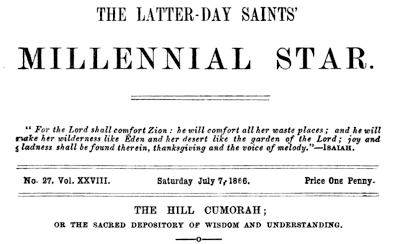On July 7, 1866, The Latter-Day Saints’ Millennial Star ran a front-page article by Orson Pratt titled “The Hill Cumorah: Or the Sacred Depository of Wisdom and Understanding.” This is in volume 28, No. 27. At the time, the Millennial Star was “Edited, Printed and Published by Brigham Young, Jun.” in Liverpool.
You can see it in the original format on google books here.
The article was republished in The Contributor in September, 1882, Vol. III, No. 12. online here. The Contributor was an independent Mormon magazine intended for the Young Men’s and Young Ladies’ Mutual Improvement Associations.
Because a lot of people have never seen this article, I’m republishing it here.
I’m not going to comment much, except to say we have to keep in mind that although Orson Pratt knew Cumorah was in New York, he speculated about the rest of the Book of Mormon geography. This is reflected in his 1879 footnotes to the Book of Mormon, in which he stated unequivocally that Cumorah was in New York but referred to other locations as possibilities; e.g., “it is believed that. Orson was not Joseph or Oliver; he didn’t experience the repository directly, so he may not have all the details correct, but there’s a lot of great material here for those who have eyes to see.
Pratt uses a lot of flowerly rhetoric, so the style seems strange to modern readers. I’ve divided the article into smaller paragraphs for easier reading. I’ve bolded some key points.
____________________
The Hill Cumorah is situated in western New York, between the villages of Palmyra and Canandaigua, about four miles from the former. It is celebrated as the ancient depository of the sacred gold plates from which the Book of Mormon was translated.
Cumorah was the name by which the hill was designated in the days of the Prophet Moroni, who deposited the plates about four hundred and twenty years after the birth of Christ. The Prophet Mormon, the father of Moroni, had been entrusted with all the sacred records of his forefathers, engraved on metalic [sic] plates. New plates were made by Mormon on which he wrote, from the more ancient books, an abridged history of the nation, incorporating therewith many revelations, prophecies, the Gospel, &c.
These new plates were given to Moroni to finish the history. And all the ancient plates, Mormon deposited in Cumorah, about three hundred and eighty-four years after Christ.
When Moroni, about thirty-six years after, made the deposit of the book entrusted to him, he was, without doubt, inspired to select a department of the hill separate from the great sacred depository of the numerous volumes hid up by his father.
The particular place in the hill, where Moroni secreted the book, was revealed, by the angel, to the Prophet Joseph Smith, to whom the volume was delivered in September, A.D. 1827. But the grand repository of all the numerous records of the ancient nations of the western continent, was located in another department of the hill, and its contents under the charge of holy angels, until the day should come for them to be transferred to the sacred temple of Zion.
Source: Letter VII

